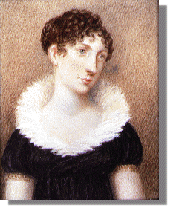| About LEMA | Find | Projects | Documents | Research | Gallery |
Elizabeth Henrietta MACQUARIE of Airds (1778-1835)1778-1804 | 1805-1807 | 1808-1824 | 1825-1835 |
Background
Early Years (1778-1804): In June 1804 Elizabeth met her cousin, Lachlan Macquarie, for the first time, at Lochbuie House on the Isle of Mull. They were both in attendance at the deathbed vigil for Murdoch Maclaine (1730-1804), 19th Laird of Lochbuie. Murdoch was the husband of Jane Campbell of Airds (c.1761-1824) and Elizabeth was at Lochbuie House assisting her elder sister maintain the Lochbuie household as Murdoch lay dying - and to help with the care of their ten (10) children (two sons and eight daughters). Macquarie had travelled to the Isle of Mull from Edinburgh in company with Elizabeth's brother, John (1767-1834), and in his 1804 diary Macquarie recorded his first impression of Elizabeth Campbell: 1804 June 27 This event was a social and marital nexus that brought together three key clans of the Inner Hebridean region on the west coast of Scotland: the Maclaines of Mull, the MacQuarries of Ulva, and the Campbells of Airds (at Appin). These families were tightly bound together by tradition, marriage and obligation. The courtship of Elizabeth and Lachlan began in the context of this place and these children. Later, the sons of her two sisters, Jane and Margaret, would accompany the Macquaries to NSW in 1809 as newly commissioned officers in the 73rd Regiment: John Maclaine (c1792-1818) and Duncan Campbell (1794-1820) 1804 August 20
Engagement (1805-1807):
Marriage (1808-1824): A daughter, Jane (1808), was born in September 1808 at Perth, Scotland, however, tragically, she died three months later on 5 December from unknown medical complications. In the period 1809-1814 Elizabeth suffered at least seven miscarriages. Finally a son, Lachlan (1814-1845), was born in Sydney on 28 March 1814. Not unexpectedly, he would become the focus of the Macquaries' private lives - doted upon and spoiled.
Widowhood (1825-1835): In the immediate months after Lachlan's death she sought to consolidate her finances by selling Lachlan's military commission to a son of the Duke of Sussex for £4500. In his Will Lachlan had provided an annuity of £300 per annum to Elizabeth for life, provided the home at Gruline and 100 acres surrounding it as a dower house, and left her the sum of £700 bequeathed to her by her father. However this money was somewhat illusory. Lord Strathallan (James Drummond) had been appointed as Lachlan Jnr's guardian and was the principal executor of Macquarie's estate that was to be held in trust for Lachlan Jnr. during his minority. Elizabeth and Strathallan clashed over the management of the estate and the education of Lachlan Jnr. Between 1825-1828 she lived a frugal existence at Barnes, in Surrey, and later in Middlesex, while Lachlan Jnr. attended school at Woodford. Each summer she took him back to Scotland to stay on their 'Jarvisfield' estate on the Isle of Mull. Throughout this period, despite the intervention and pleadings of friends and parliamentary contacts seeking to acquire a pension for her in acknowledgement of her husband's administration. She refused to accept the amount of £400 offered by Lord Bathurst in September 1825 until the written responses prepared by Macquarie in 1823 (against the matters raised in the Bigge Reports) were tabled in parliament. Finally in June 1828 the Colonial Office agreed to order the papers to be printed as a Parliamentary Paper (25 June) and she then accepted her pension. In 1825 Elizabeth learned that her favourite friend, Miss Henrietta Meredith, had died and bequeathed her £2000 as well as a small house at 58 Upper Charlotte Street, near Portland Place, in London. She lived here throughout 1828-1829 while Lachlan Jnr. attended school in Finchley. In 1830 Elizabeth moved to Aberdeen where she rented a house for six months at Sunny Bank (at 7 guineas a month). In 1831 Lachlan (now aged 16) insisted on joining the army and Elizabeth purchased an ensigncy for him in the 42nd. Regiment of Foot. After he joined his regiment at Birmingham Elizabeth returned to Mull to take up residence at 'Jarvisfield'. She found that conditions on the estate were far from ideal; for although she had the use of Gruline House for life, James Drummond (8th Viscount Strathallan, and guardian of Lachlan) insisted as a trustee that she buy her cattle from the Macquarie estate whenever she wanted to stock her farm. In 1827 she had given power of attorney to Richard Fitzgerald over her shares in the Bank of New South Wales and the livestock that she had left on Henry Antill's property at Picton. He ascertained that she had £500 in the Bank and that her stock stood at 950 head of cattle. Between 1829-1835 Fitzgerald sent her £869 (approx. £145 per annum). Elizabeth's final years in Scotland were filled with sadness and failing personal health. Her brother John died on 7 November 1834 and Elizabeth Macquarie died peacefully at Gruline House on 11 March 1835 (at 2 pm) aged 56.
Return to Biographies | Home |






